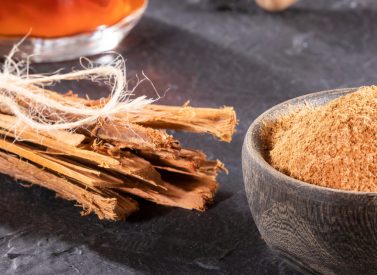Constituents:
- Pentacyclic oxindole alkaloids (POAs) including (uncarine C), isopteropodine (uncarine E), speciophylline (uncarine D), uncarine F, mitraphylline, and isomitraphylline
- Tetracyclic indole alkaloids (TOAs) including rhynchophylline, isorhynchophylline, corynoxeine, and isocorynoxeine.
- Carboxy alkyl esters (CAEs)
- Triterpenes: ursolic acid derivatives, quinovic acid glycosides, and oleanolic acid derivatives
- Polyhydroxylated triterpenes
- Sterols including ß-sitosterol, stigmasterol and campesterol
- Flavonoids (procyanidins: catechin, epigallocatechin, epicatechin and epigallocatechin)
- Tannins
Medicinal actions:
- Anti-inflammatory
- Antioxidant
- Immunomodulator
Traditional use:
Cat’s claw is native to the South and Central American tropical rain forest and an important Indigneous Peruvian medicine, specifically of the Asháninka Indians. A decoction of the bark has been used to treat many chronic and degenerative processes (including cancer & tumors), inflammatory conditions (arthritis), gastric ulcers, intestinal colic, diarrhea, venereal diseases, snake bite, diabetes, asthma, uterine hemorrhage, internal wounds, kidney damage, and is believed to have tonic or restorative properties during convalescence or debility.
Evidence Based use:
- May be useful in chronic inflammatory conditions including arthritis (rheumatoid & osteo), gastritis, ulcerative, colitis, allergies, bronchitis, and asthma.
- As immune support for infections and chronic immune deficiency disorders such as HIV and post-viral syndromes.
- Has been shown to increase vitality and reduce side effects in cancer patients undergoing chemotherapy, radiation, or surgery.
- Has improved immune function in HIV/AIDS (shown to stabilize and/or reduce CD4-cell count), reduced HIV-related symptoms, and increased vitality in HIV patients receiving antiretroviral treatment.
- As an anti-inflammatory and antioxidant has demonstrated moderate activity against COX-1 and COX-2, inhibition of NF-kB synthesis in vitro and in animal models.
- As a topical antiviral may be active against Herpes simplex and Varicella-zoster.
- Has been proposed as a treatment for Alzheimer’s disease and type II diabetes (inhibition of amyloid formation in vitro).
Mechanism of Action + Pharmacology:
- Two chemotypes of Cat’s Claw are considered to have separate pharmacological properties. One contains pentacyclic oxindole alkaloids (POAs) with only traces of tetracyclic oxindole alkaloids (TOAs), the other contains both POAs and TOAs. TOAs can have an immune-suppressing activity, and it is ideal to use the chemotype that is high in POAs and very low in TOAs.
- Pentacyclic oxindole alkaloids (POAs) largely affect cellular immunological systems, however bioactivity is likely spread over a wide range of constituents.
- In vitro POA stimulated phagocytosis and increased the proliferation of normal resting or weakly activated human B and T lymphocytes. Note: POA did not directly influence the proliferation, but induced endothelial cells to release a yet-to be-identified factor which influences the proliferation of lymphocytes. In contrast, TOA acted antagonistically towards the release of this factor.
- Increased granulocyte-macrophage progenitors in bone marrow (which may lead to an efficient and sustained response of phagocytes) and stimulated phagocytic activity of peripheral blood leukocytes in animal models.
- Anti-tumor effects against proliferation of leukemia cells in vivo and estrogen-dependent tumours in vitro, and anti-mutatgenic activity against photomutagenesis induced by psoralen and UV-A radiation demonstrated in vitro. Doses have correlated linearly and significantly with a decrease of mutagenic activity in the urine of adult smokers.
- Antiviral activity has been demonstrated for relatively high concentrations of certain quinovic acid glycosides in vitro.
Pharmacy:
- Decoction
- Tincture
- Tablets
Safety + Toxicity Concerns:
- In high doses may cause diarrhea, constipation and indigestion.
- Theoretical contraindication in leukemia patients awaiting bone marrow or organ transplant and persons with iatrically-induced immunosuppression (e.g. chemotherapy, organ transplants), autoimmune disease, multiple sclerosis, or tuberculosis.
- Mild cases of red blood cell elevation have been reported in AIDS patients and patients receiving large doses of chemotherapy. In rare cases, elevated uric acid values were observed, and extensive cell die-off in tumor patients may cause lytic fever lasting 1–2 weeks.
- Use caution in pregnancy and lactation.
- Do not use in children under 3 years old.
- Acute renal failure caused by “cat’s claw’” has been reported in a 35-year-old Peruvian female with systemic lupus erythematosus. The contents of the capsules were not analysed and the duration of treatment was not stated.
Interactions:
- May potentially reduce the rate of metabolism and thus increase serum levels of drugs taken orally via inhibition of CYP3A4.
- Potential antagonistic effects alongside immunosuppressive medications.
- According to one European manufacturer, is suggested to “take between chemotherapy treatments and after completion, but not with chemotherapy treatments; Do not take in conjunction with passive animal vaccines, intravenous hyperimmunoglobulin therapy; intravenous thymic extracts, drugs using animal protein or peptide hormones (e.g., bovine or porcine insulin), cryoprecipitates, or fresh blood plasma”. The rationale behind these comments is not known.
- Theoretically may increase the effects of anticoagulants and antihypertensives (based on research on TOA components isolated from Uncaria spp.)








